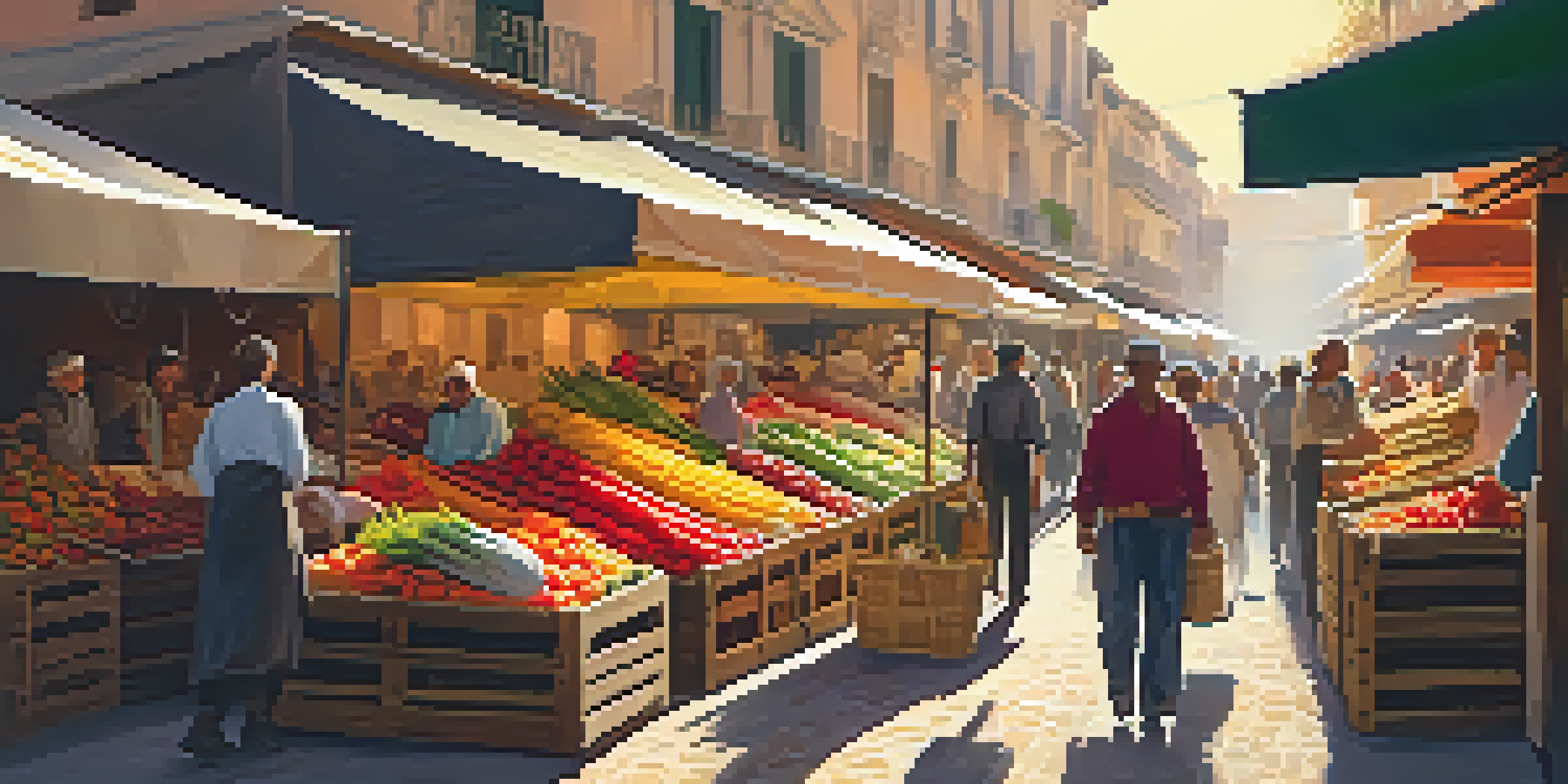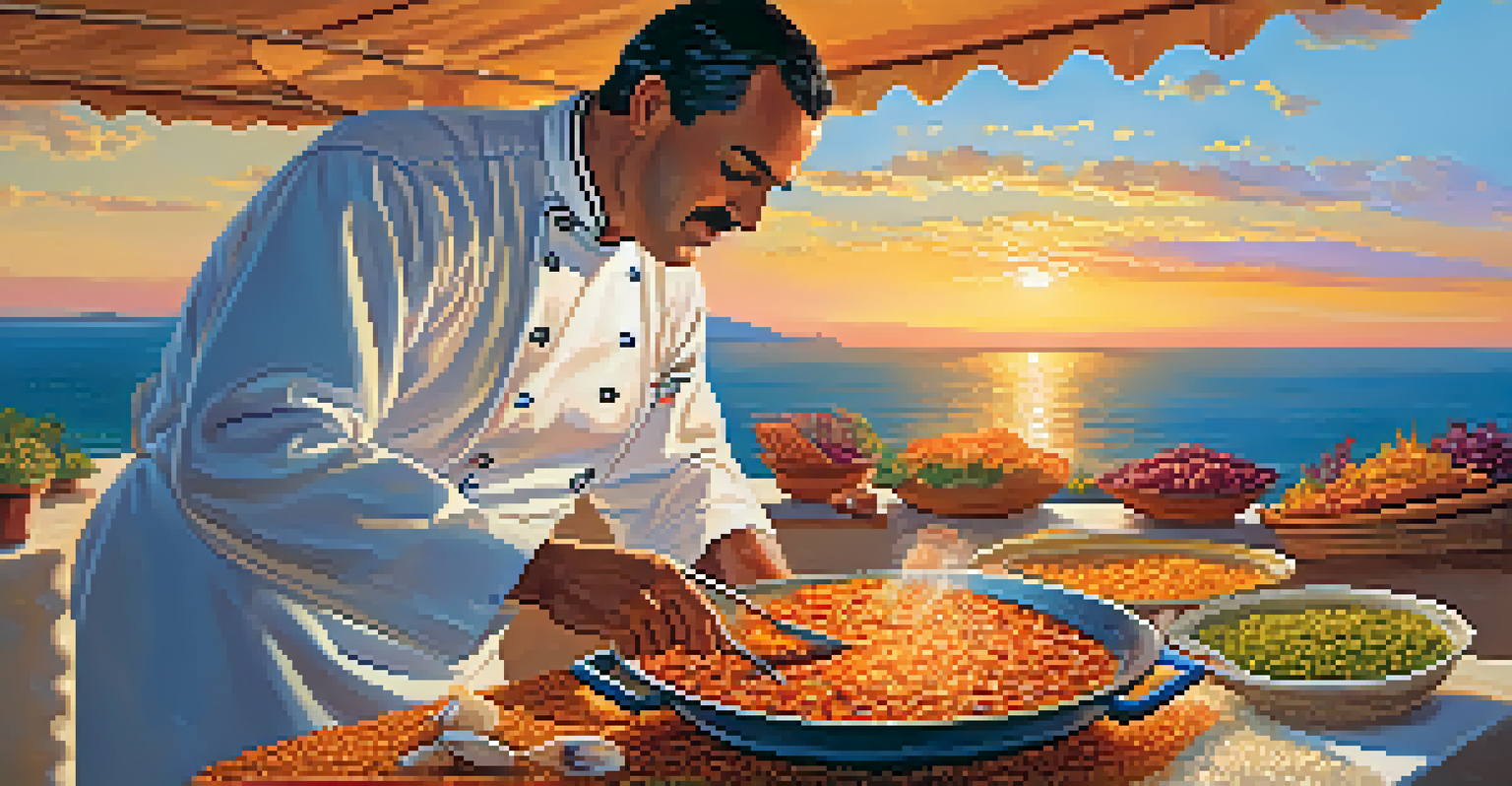Exploring the Roots of Spanish Cuisine: A Historical Overview

The Ancient Origins of Spanish Cuisine
Spanish cuisine has deep roots that can be traced back to ancient civilizations. The Iberian Peninsula was home to various cultures, including the Romans and Moors, each leaving their mark on the culinary landscape. For instance, the Romans introduced techniques like the use of olive oil, which is now a staple in Spanish cooking.
Food is our common ground, a universal experience.
Moreover, the influence of the Moors from the 8th to the 15th century brought spices and ingredients such as saffron and citrus fruits. These additions transformed the flavor profile of traditional dishes, creating a unique blend that defines Spanish cuisine today. Imagine a simple dish of rice; now, sprinkle in saffron and you've got a delightful paella!
As we delve into Spain's culinary past, it's essential to see how these early influences set the foundation for a complex food culture. The interplay of ingredients and techniques from different cultures paved the way for the diverse regional cuisines we enjoy across Spain today.
The Role of Geography in Shaping Flavors
Spain's geographical diversity plays a crucial role in its culinary heritage. With coastlines, mountains, and fertile plains, each region boasts unique ingredients and cooking methods. For example, the Mediterranean coast is known for its seafood and fresh vegetables, while the inland areas favor hearty meats and legumes.

This regional variation means that a dish like gazpacho, a refreshing cold soup, is vibrant with vegetables from Andalusia, while a hearty cocido from Madrid combines various meats and chickpeas. Understanding these geographical influences helps us appreciate the wide range of flavors in Spanish cuisine.
Historical Influences on Cuisine
Spanish cuisine has evolved through the integration of various cultural influences, including Roman, Moorish, and post-colonial ingredients.
Additionally, the climate in various regions affects what can be grown, harvested, and ultimately cooked. The interplay of local ingredients and weather patterns has created a tapestry of culinary traditions that are as varied as the landscapes of Spain.
The Impact of Trade and Exploration
The Age of Exploration in the 15th century opened new trade routes, introducing exotic ingredients to Spain. With explorers like Columbus bringing back goods from the Americas, staples such as tomatoes, potatoes, and chocolate became integral to Spanish cooking. Can you imagine a Spanish dish without tomatoes? It's hard to envision!
Cooking is like love. It should be entered into with abandon or not at all.
This influx of new ingredients not only diversified the Spanish palate but also influenced traditional cooking practices. Dishes evolved to incorporate these new flavors, leading to the creation of iconic meals like salsa and churros. The fusion of old and new ingredients highlights the adaptability of Spanish cuisine.
Trade also facilitated cultural exchanges that enriched Spain's food traditions. As flavors from different parts of the world mingled, Spanish recipes became a reflection of global influences, showcasing a culinary history that is both rich and complex.
Regional Specialties: A Culinary Map of Spain
Spain is renowned for its regional cuisines, each offering a distinct taste of local culture and traditions. For instance, in the Basque Country, you'll find pintxos—small snacks that showcase the region's love for fresh ingredients and bold flavors. On the other hand, Andalucía is famous for its tapas, which encourage communal dining and sharing.
Traveling through Spain means embarking on a culinary journey where each region tells its own story through food. In Catalonia, saffron-infused dishes like fideuà highlight local seafood, while Galicia is celebrated for its octopus dishes, showcasing the coastal bounty. Each region’s specialties are a testament to its unique history and geography.
Regional Diversity in Flavors
Spain's unique geography results in diverse regional cuisines, each reflecting local ingredients and cooking traditions.
By exploring these regional differences, we gain a deeper understanding of Spain's culinary identity. It's like a mosaic where every dish contributes to the overall picture, creating a vibrant and diverse food culture that is cherished both locally and globally.
The Influence of Historical Events on Cuisine
Historical events have significantly shaped Spanish cuisine over the centuries. The Reconquista, for instance, led to the mixing of Christian and Moorish culinary traditions, resulting in a rich tapestry of flavors and techniques. This blending is evident in dishes like paella, which combines rice, seafood, and spices.
Additionally, the Spanish Civil War and subsequent Franco regime affected food availability and cultural practices. Many traditional recipes were lost or altered during these challenging times, but they also spurred a movement to preserve and revive regional cooking. This resilience is a hallmark of Spanish culinary history.
Understanding these historical contexts helps us appreciate the food we enjoy today. Each dish carries stories of survival, adaptation, and the enduring spirit of the Spanish people, making dining an experience that connects us to the past.
Modern Trends in Spanish Cuisine
Today, Spanish cuisine is experiencing a renaissance as chefs innovate while honoring traditional recipes. The rise of molecular gastronomy has introduced new techniques that transform classic dishes into modern culinary art. Think of a deconstructed tortilla española that showcases the essence of the dish in a new light.
Moreover, there’s a growing emphasis on sustainability and local sourcing, with chefs seeking to highlight seasonal ingredients. This trend not only supports local farmers but also enhances the quality and flavor of the dishes served. It's a return to roots that celebrates the land and its bounty.
Celebration of Culinary Traditions
Festivals and communal dining in Spain highlight the cultural significance of food, connecting people through shared culinary experiences.
As Spanish cuisine evolves, it continues to draw from its rich history while embracing contemporary influences. This blend of old and new ensures that Spanish food remains vibrant, relevant, and exciting for chefs and diners alike.
Celebrating Spanish Cuisine: Festivals and Traditions
Spanish cuisine is not just about food; it's a celebration of culture and community. Festivals like La Tomatina and San Sebastián's Gastronomy Week bring people together to honor traditional dishes and local ingredients. These events are as much about the experience and camaraderie as they are about the food.
During these festivities, locals and visitors alike indulge in regional specialties, showcasing the diversity of Spanish cuisine. Imagine the joy of tasting a variety of tapas while mingling with friends and family, all under the warm Spanish sun. It's an immersive experience that highlights the importance of food in social connections.

These culinary celebrations serve as a reminder of the deep-rooted traditions that continue to shape Spanish cuisine. As we partake in these cultural events, we not only enjoy delicious food but also connect with the rich history and vibrant community that surrounds it.